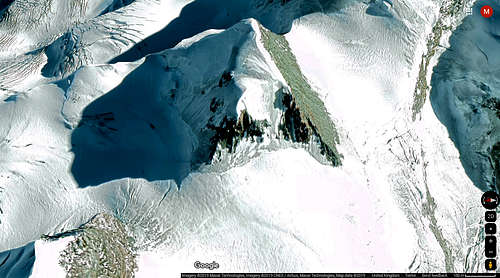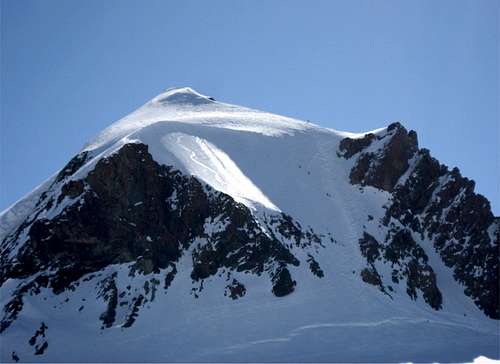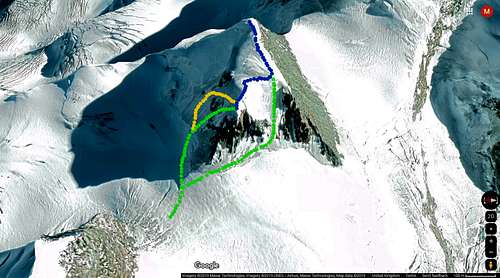|
|
Route |
|---|---|
|
|
Ice Climbing |
|
|
Summer |
|
|
Half a day |
|
|
PD- |
|
|
Overview
Pollux is a 4092m high summit in the Monte Rosa massif on the edge between the Breithorn range and the Lyskamm, where it sits together with its higher twin, Castor (4220m). This page is dedicated to the West-Face route which is technically the easiest route to the summit, however because it is often not 'in good shape' most climbers prefer the SE- or the SW-ridges. A great page of the SW-ridge can be found here. A good page concerning the SE-ridge is here. If conditions are good however the West-Face route should be the easiest one up ... or well at least the snowiest or iciest.

This is a nice June 2019 video of a west-face ascent!
Getting There
There are several ways of getting there and I hope to provide a full overview in due time. However lets start with the two easiest access routes:
1] From Klein Matterhorn:
If you are based in Zermatt no doubt the easiest access is via the Klein Matterhorn cable car. It is a 2h30m glacier hike across the Breithorn plateau from the cable car station to the Schwarztor col between Pollus and Roccia Nera. You will see most climbers continue to the foot of SE- or SW-ridges and pass by the Schwarztor, but for the West-Face route you will want to go to the Schwarztor.
2] From Testa Grigia:
You can either hike up to Testa Grigia from Breuil-Cervinia (about 3 hours) or take a succession of three cable cars (around 45m). From Testa Grigia follow the usually well established trails to the Breithorn plateau. In all it is about 3h15m to the Schwarztor.
Route Description
From the Schwarztor the route you take depends very much on the conditions you find. The main reason why many climbers avoid the west-face is this dependence on conditions which can vary quite significantly along the climb. When conditions look good around the bergschrund the climb can nevertheless become a challenging ice-exercise higher-up the west-face. Excellent route-finding skills on ice are therefor quite useful when going for the west-face in moderate or not-so-good conditions. But if you dislike rock as much as I do then any snow-ice route seems more attractive. Another plus of this route: due to its increasingly bad reputation it usually is less crowded then the SE- or SW-ridge routes.
Find a good place where to cross the bergschrund and take it from there. Depending on your skill and experience you can either opt for a steeper (up to 50 degrees) climb or a zig-zag traverse that effectively gives you less steepness for a slightly longer path. The steepness will not pose so much of a challenge by itself, however prepare for bare ice occaissionally in a bad state sometimes dusted with a fresh but thin layer of snow that makes it look better than it is.

If you go to far and to deep down the Schwarztor you will find yourself effectively joining the North-ridge route which is AD. Once the slope levels off a short traverse takes you to the standard summit ridge where you meet the people who took the SW-ridge route.

Essential Gear
Although in principle ice axe, crampons, rope, i.e. the standard glacier gear will do (with crevasse rescue kit) I would recommend bringing along an additional pair of icescrews just in case you do want to pitch the route because of the conditions you find. It is quite hard to get proper reports about the condition of the west-face before climbing as most guides take their clients along the roped SW-ridge route and seem to ignore the West-Face. Because access is so easy and the glacier 'stroll' across the Breithorn plateau is not very demanding bringing a little extra gear shouldn't be to much of a problem.
External Links
Here is a 2019 report on this climb on CampToCamp.
Here is a 2020 report on this climb on CampToCamp.
A video of an April 2015 descent down the west-face: it gives a reasonable idea of the steepness of the slope on the west-face.
A ski descent in January 2011 which, again, gives you an idea of topography but not of the actual climbing season conditions you'll encounter.

